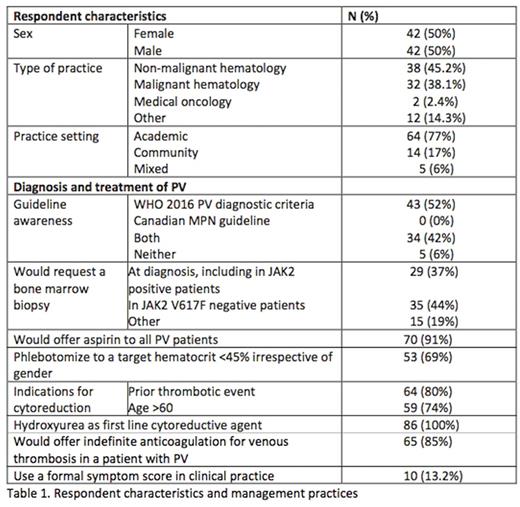Abstract
Introduction:
The 2016 World Health Organization (WHO) revised classification criteria for the diagnosis of polycythemia vera (PV) allow for an earlier detection of masked PV. Changes in diagnosis include a lower hemoglobin threshold to a hemoglobin of >165 g/L (160 g/L in women) from >185 g/L (165 g/L in women), and inclusion of a bone marrow biopsy (Arber et al., 2016).
The literature is scarce about the clinical uptake of new diagnostic algorithms for PV. Our objectives were, in a cohort of Canadian Hematologists, to identify how the newly revised 2016 WHO diagnostic criteria of PV are being incorporated into hematology practice, and if the treatment of PV is comparable to the approaches outlined by the Canadian Myeloproliferative Neoplasm (MPN) Group (Sirhan et al., 2015). These national guidelines differ from the WHO criteria in that they suggest a diagnosis of PV can be made without a bone marrow biopsy if there is presence of elevated red blood cell volume as per the 2008 WHO criteria.
Methods:
An institution research ethics board approved cross-sectional survey of practicing Canadian hematologists/oncologists was conducted. Potential participants were drawn from 299 currently active members of the Canadian Hematology Society (CHS) over a 10 week period. The survey was offered in English and French and was collected anonymously using an online survey-distributing website, SurveyMonkey.com™. Paper copies of the survey were also distributed at the Leukemia Day conference in Toronto, April 6th, 2017. We assessed whether age, sex, practice type, practice setting, average number of PV patients seen per year, and awareness of the WHO 2016 criteria and/or the Canadian MPN Group guidelines influences management decisions. Univariate analysis was conducted with Fisher's exact test. For univariable analysis, Fisher's exact test was used if the explanatory variable was categorical and the Wald chi-square test from a multiple logistic regression was used if the explanatory variable was continuous. For multivariable analysis, logistic regression using the penalized maximum likelihood method was used to test the joint significance of explanatory variables on outcome. Penalized likelihood is a general approach to reducing small-sample bias in maximum likelihood estimation. All analyses were conducted using SAS version 9.4.
Results:
86 respondents completed the survey in total, (69 online surveys and 17 with paper copies). Table 1 describes the respondents' characteristics, diagnosis and treatment approach. The mean number of patients seen by respondents was 22.6 (SD 23.6) with a median of 15 (range of 0-120). Respondents who saw more PV patients yearly were more likely to use a formal symptom assessment score, such as the MPN10 score or the Edmonton Symptom Assessment System, on univariate analysis (P=0.015). Type of practice was associated with respondents offering aspirin to all PV patients without contra-indications to anti-platelet therapy (P=0.0009) on univariate analysis while practice setting or number of PV patients seen per year did not. Respondents who were aware of the Canadian MPN Group guidelines were more likely to phlebotomize patients to a target hematocrit of <45% irrespective of gender (P=0.042). Younger practitioners were more likely to use age over 60 as an indication for initiating cytoreductive therapy which was independent of other confounders in the multivariable analysis (P=0.0006). Most (85.3%) respondents would recommend indefinite anticoagulation in patients with PV who developed unprovoked venous thromboembolism (in whom there were not contraindications to anticoagulation).
Discussion:
The survey confirmed that heterogeneity of practice in diagnosis and management of PV among Canadian hematologists remains despite the revised 2016 WHO classification criteria and the guidelines set forth by the Canadian MPN Group. It has also shown that awareness of the guidelines and the updated diagnostic criteria translated into adopting approaches advocated in these documents. The survey suggests that targeted education in specific segments of the PV treatment providers may result in wider adoption of the guidelines and diagnostic criteria.
Kuo: Alexion: Consultancy, Honoraria, Other: Site-PI for ALXN1210-PNH-301, ALXN1210-PNH-302, ALXN1210-aHUS-311, PKD natural history study, aHUS natural history study (M11); Celgene: Consultancy, Other: Site-PI on ACE-536-B-THAL-001; Agios: Consultancy, Other: Site-PI for AG-348-003 and PKD natural history study; Novartis: Consultancy, Honoraria; Pfizer: Other: Site-Pi for GMI1070 study; Phoenicia Biosciences: Other: Scientific collaboration; Abfero: Other: Scientific collaboration. Panzarella: Celgene Canada: Consultancy. Gupta: Incyte: Consultancy, Research Funding; Novartis: Consultancy, Honoraria, Research Funding. Trinkaus: Janssen and Amgen: Honoraria.
Author notes
Asterisk with author names denotes non-ASH members.


This feature is available to Subscribers Only
Sign In or Create an Account Close Modal